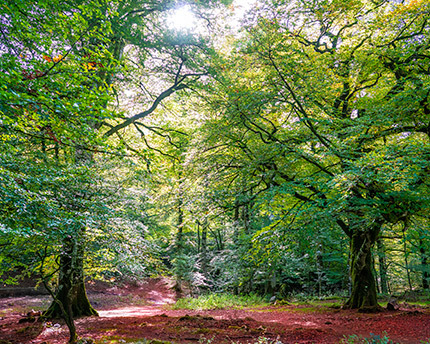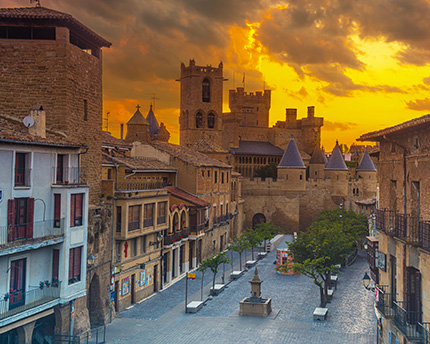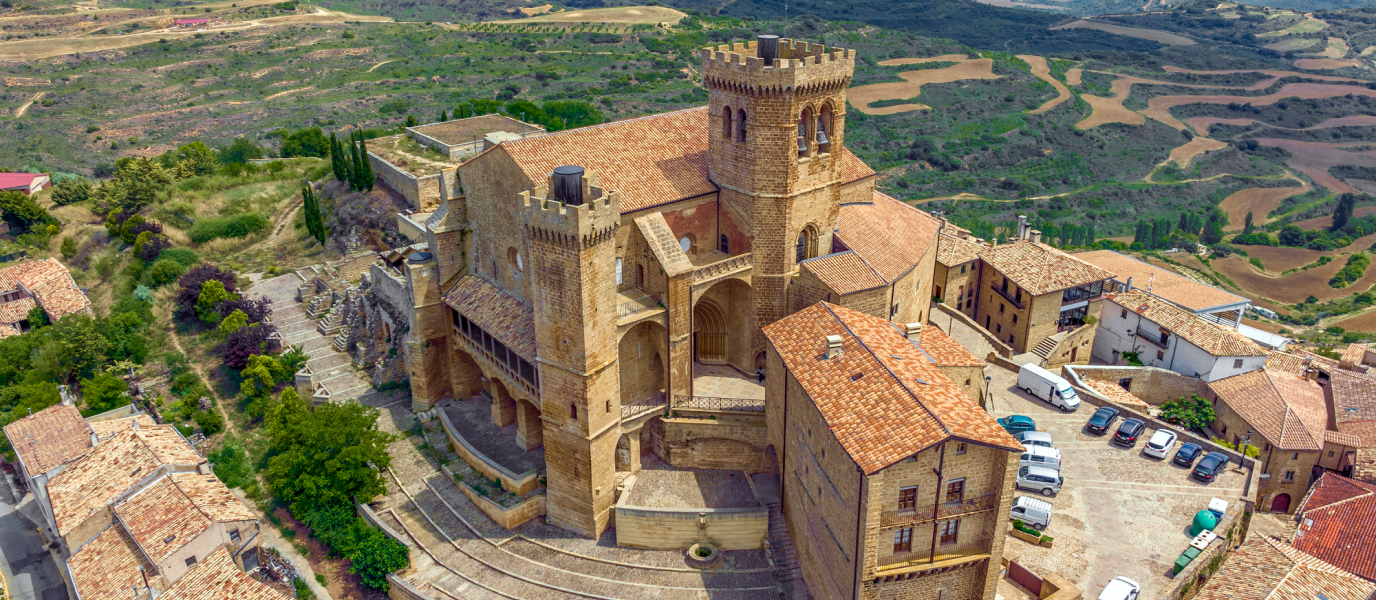The Irati Forest is a wonderful destination, especially in autumn when the golden, dun, red and ochre leaves are at the height of their splendour. Despite having suffered extensive logging in the 15th century, the forest remains vast and has stunning trails that are bursting with magic, legends, and unspoilt beauty.
Irati Forest is one of the best beech and fir forests in Europe and is only beaten in size by the Black Forest in Germany. It has a wealth of flora and fauna, and visitors can pick from a huge range of hiking trails.
It’s the perfect option for travellers who are visiting Pamplona or Navarre and would like to spend a day or two in the fresh air of the trees.
- Natural environment
- How to get there
- Flora and fauna in the forest
- Nature reserves
- Where to eat in the area
- What to see nearby
Natural environment
The Irati Forest covers an area of more than 17,000 hectares and lies in a basin surrounded by mountains in the heart of the Eastern Navarran Pyrenees. It spreads across the Aezkoa and Salazar valleys, crossing into the French Basque Country and covering the Cize and Soule valleys in the Atlantic Pyrenees in south-west France.
On the Spanish side, the Irati Forest lies in the Irati River valley and is bordered to the west by the Orzanzurieta and Roncesvalles mountains, to the east by Orhi Mountain, and to the south by the Abodi mountains.
The entire Irati Valley is a Special Bird Protection Zone because of its ecological importance, and several parts of it have also been made nature and integral reserves.
How to get there
You can travel to the Irati Forest from Pamplona by car in just over an hour. There are two popular entrances: Orbaitzeta, in Aezkoa Valley, and Ochagavía, in Salazar Valley.
You reach Orbaitzeta by taking the A21 from Pamplona and then, at Aoiz, continuing along the NA 1720, NA 140 and NA-2030.
You reach Ochagavía by taking the A21 from Pamplona, then taking exit 35 and continuing along the NA-150 to Lumbier, where you take the NA-178 and carry along the Salazar road to Ochagavía.
If you’re travelling from Madrid or Barcelona, two large provincial capitals, both are about the same distance away by car: over 400 km and a journey of around five hours.
Flora and fauna in the forest
The Irati Forest is a damp environment, and this huge forest is full of rivers and streams that help plant and animal life flourish.
Beech and fir trees are two of the most important plant species, the European beech and silver fir being the most common. You’ll also spot other species that are typical to humid zones and the understorey such as birch, yew, holly, maple, lime, bramble, mushrooms, mountain ash, oak, willow, fern, and moss.
This spectacular plant world provides shelter and homes for fauna that includes deer, roe deer, boar, and red squirrels, among other animals. Meanwhile, griffon vultures, golden eagles, and peregrine falcons, plus many other birds, circle the skies above the forest.
Visitors to the Irati River might also be lucky enough to spot otters, Greek tortoises, snub-nosed vipers, and exotic species like the Pyrenean desman (a member of the mole family), Eurasian water shrew, and white-throated dipper.
Nature reserves
The Irati Forest has three protected areas that have been made nature or integral reserves:
Lizardoia natural reserve. 64 hectares of beech and fir forests spread across La Cuestión Mountain at an altitude of between 850 and 1,125 m. Twenty hectares of the reserve are pristine forest. It’s the most ecologically valuable area of the Irati Forest and in 2017 it was made a UNESCO World Heritage Site as part of the Ancient and Primeval Beech Forests of the Carpathians and Other Regions of Europe.
Mendilatz natural reserve. This 119-hectare space contains forests with huge beech trees and other species and is found on Mendilatz Mountain in Orbaitzeta at an altitude of 1,100 m. It’s also a limestone rock area and has frequent rainfall.
Tristuibartea natural reserve. This is a 55-hectare forest with oaks in the lower areas and beeches at higher altitudes. It’s on the north side of Petxuberro Mountain in Villanueva de Aezkoa, at an altitude of 940 m.
The best trails
On foot, bike, with snowshoes or skies, in spring, summer, autumn and winter… Any season is a wonderful time to discover the Irati Forest by exploring its routes and trails.
There are trails for children and older people, and routes with varying levels of difficulty that lead hikers to mountain peaks, the deepest parts of the forest and other magical spots. They’re split between trails in the Aezkoa Valley and the Salazar Valley.
Great choices in the Salazar Valley include:
Errekaidorra. Circular route that starts at the Casas de Irati. It’s an easy route that takes you to information points where you can learn how wood from the forest was once used to make ships’ masts, furniture and as charcoal.
Gartxot. 12-km circular route with an elevation gain of 600 m that starts from the centre of the Irati-Abodi Mountain. The route has views of mountain peaks in the Pyrenees and the Irati Valley. The route’s name refers to the legend of Gartxot, a bard from Navarran mythology.
Wonderful trails in the Aezkoa Valley include:
Los Parísos-Erlán. Easy, circular route that’s just over 4 km long with few changes to the elevation, so it’s suitable for people of all ages and fitness levels. It starts from the Irabia Reservoir car park and borders this beautiful expanse of water, taking you along forest tracks and woodcutters’ paths through a stunning beech and fir forest.
Where to eat in the area
You can enjoy the best of Navarran food in the Irati Forest with the added attraction of foods gathered from the forest (e.g. mushrooms) and also traditional Pyrenean dishes (game, such as boar and deer, sheep cheese, migas de pastor, etc.) And of course, all these delights can be accompanied with a glass of pacharán or shot of basaka, an artisan wild apple liqueur.
You’ll find a good number of bars and restaurants in the Salazar and Aezkoa valleys, in the towns of Orbaitzeta and Ochagavía, as well as other towns and villages in the area.
What to see nearby
You’ll love exploring the vast forests of beech, fir and other plant species along routes and trails in the Irati Forest, but don’t forget that there are other points of interest too.
Here are some highlights:
Orbaizeta Royal Munitions Factory. Deep in Txangoa gorge, at the Aezkoa entrance into the Irati Forest, you can still see the ruins of the old Orbaizeta Royal Munitions Factory. It was built in the 17th century to supply King Charles III with munition and arms.
Megalithic complex of Azpegui. The megalithic complex of Azpegui is a few kilometres from Orbaizeta, on the French border. It’s a series of prehistoric rocks and dolmens that are set into the ground to form a circle or ellipse. Visitors love soaking up the enigmatic and magical atmosphere of the site.
Remendía, nearby villages and Port de Larrau. Remendía is a rest area and natural space found between the Aezkoa, Salazar and Urraul valleys where you can take a break or hike a trail. And Port de Larrau, at an altitude of 1,578 m, is the perfect spot to enjoy panoramic views of the Irati Valley. It’s just under 20 km from Ochagavía. Finally, if you have time, keep following the road and stop off at the different villages you pass on the way to Roncevaux.































































